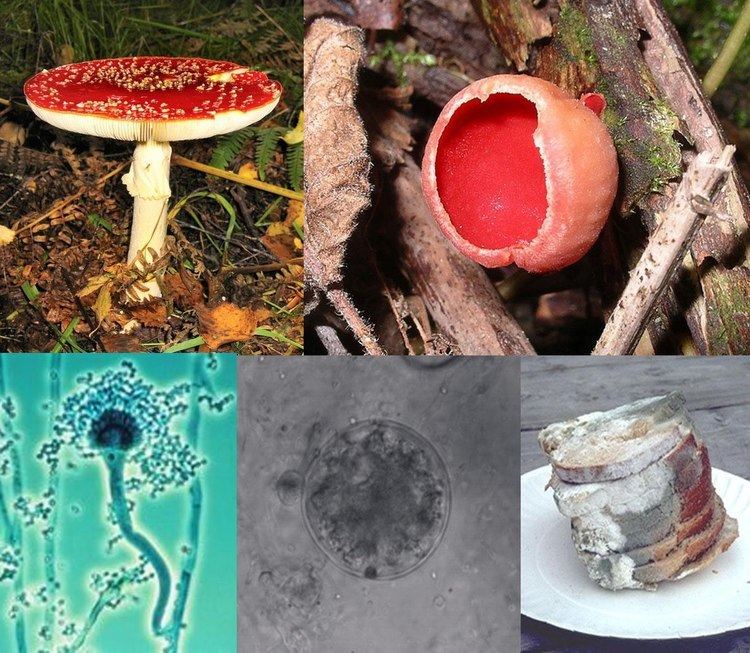 | ||
The evolution of fungi has been going on since fungi diverged from other life around 1.5 billion years ago, (Wang et al., 1999) with the glomaleans branching from the "higher fungi" at ~570 million years ago, according to DNA analysis. (Schüssler et al., 2001; Tehler et al., 2000) Fungi probably colonized the land during the Cambrian, over 500 million years ago, (Taylor & Osborn, 1996) but terrestrial fossils only become uncontroversial and common during the Devonian, 400 million years ago.
Early fungi
A rich diversity of fungi is known from the lower Devonian Rhynie chert; an earlier record is absent. Since fungi do not biomineralise, they do not readily enter the fossil record; there are only three claims of early fungi. One from the Ordovician has been dismissed on the grounds that it lacks any distinctly fungal features, and is held by many to be contamination; the position of a "probable" Proterozoic fungus is still not established, and it may represent a stem group fungus. There is also a case for a fungal affinity for the enigmatic microfossil Ornatifilum. Since the fungi form a sister group to the animals, the two lineages must have diverged before the first animal lineages, which are known from fossils as early as the Ediacaran.
In contrast to plants and animals, the early fossil record of the fungi is meager. Factors that likely contribute to the under-representation of fungal species among fossils include the nature of fungal fruiting bodies, which are soft, fleshy, and easily degradable tissues and the microscopic dimensions of most fungal structures, which therefore are not readily evident. Fungal fossils are difficult to distinguish from those of other microbes, and are most easily identified when they resemble extant fungi. Often recovered from a permineralized plant or animal host, these samples are typically studied by making thin-section preparations that can be examined with light microscopy or transmission electron microscopy. Compression fossils are studied by dissolving the surrounding matrix with acid and then using light or scanning electron microscopy to examine surface details.
The earliest fossils possessing features typical of fungi date to the Proterozoic eon, some 1,430 million years ago (Ma); these multicellular benthic organisms had filamentous structures with septa, and were capable of anastomosis, in which hyphal branches recombine. More recent studies (2009) estimate the arrival of fungal organisms at about 760–1060 Ma on the basis of comparisons of the rate of evolution in closely related groups. For much of the Paleozoic Era (542–251 Ma), the fungi appear to have been aquatic and consisted of organisms similar to the extant Chytrids in having flagellum-bearing spores. Phylogenetic analyses suggest that the flagellum was lost early in the evolutionary history of the fungi, and consequently, the majority of fungal species lack a flagellum. The evolutionary adaptation from an aquatic to a terrestrial lifestyle necessitated a diversification of ecological strategies for obtaining nutrients, including parasitism, saprobism, and the development of mutualistic relationships such as mycorrhiza and lichenization. Recent (2009) studies suggest that the ancestral ecological state of the Ascomycota was saprobism, and that independent lichenization events have occurred multiple times.
The fungi probably colonized the land during the Cambrian (542–488.3 Ma), long before land plants. Fossilized hyphae and spores recovered from the Ordovician of Wisconsin (460 Ma) resemble modern-day Glomerales, and existed at a time when the land flora likely consisted of only non-vascular bryophyte-like plants. Prototaxites, which was probably a fungus or lichen, would have been the tallest organism of the late Silurian. Fungal fossils do not become common and uncontroversial until the early Devonian (416–359.2 Ma), when they are abundant in the Rhynie chert, mostly as Zygomycota and Chytridiomycota. At about this same time, approximately 400 Ma, the Ascomycota and Basidiomycota diverged, and all modern classes of fungi were present by the Late Carboniferous (Pennsylvanian, 318.1–299 Ma).
Lichen-like fossils have been found in the Doushantuo Formation in southern China dating back to 635–551 Ma. Lichens were a component of the early terrestrial ecosystems, and the estimated age of the oldest terrestrial lichen fossil is 400 Ma; this date corresponds to the age of the oldest known sporocarp fossil, a Paleopyrenomycites species found in the Rhynie Chert. The oldest fossil with microscopic features resembling modern-day basidiomycetes is Palaeoancistrus, found permineralized with a fern from the Pennsylvanian. Rare in the fossil record are the homobasidiomycetes (a taxon roughly equivalent to the mushroom-producing species of the agaricomycetes). Two amber-preserved specimens provide evidence that the earliest known mushroom-forming fungi (the extinct species Archaeomarasmius legletti) appeared during the mid-Cretaceous, 90 Ma.
Some time after the Permian-Triassic extinction event (251.4 Ma), a fungal spike (originally thought to be an extraordinary abundance of fungal spores in sediments) formed, suggesting that fungi were the dominant life form at this time, representing nearly 100% of the available fossil record for this period. However, the relative proportion of fungal spores relative to spores formed by algal species is difficult to assess, the spike did not appear worldwide, and in many places it did not fall on the Permian-Triassic boundary.
